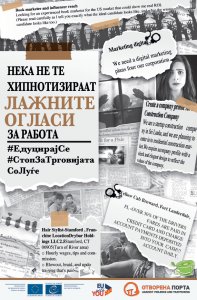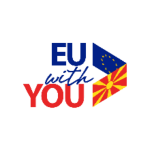
Within our co-operation with the European Union and the Council of Europe, as one of the grantees on their joint initiative– „Horizontal Facility for the Western Balkans and Turkey 2019-2022“ (Horizontal Facility II), Open Gate organised an open call for young upcoming graphic designers!
Trafficking in human beings is a serious and complex problem and one of the growing forms of organised crime on a global scale. The process of human trafficking implies a horrendous exploitation of the human body and labour, violating the most fundamental of human rights- from delimiting communication and movement, to violence and abuse.
Graphic design is definitely seen as the art or the modern generations – this is why we decided to target young upcoming designers who transferred their creativity into creating effective awareness raising graphic designs which would be part of the campaign – “Opportunity or Exploitation”.
Today we are presenting you Teodora Krstveska, the 1st place awarded design.
A few words about yourself and the motivation to apply for this competition?
My name is Teodora Krstevska, I am 18 years old and I live in Bitola. I expressed my desire to design as a child with my several attempts to design posters for decorating my bedroom. After that I had several volunteer designs, and the last thing that made me proud was making a poster for a youth exchange organized by another NGO in my home town and diplomas for literature readings in my high school.
I get the greatest support and advice from my aunt who constantly encourages me to continue in the direction I want and for that I am immensely grateful.
The motive for applying for this competition was for my pet – my dog and best friend Baster. He has had health problems for a year now, and I wanted to start buying medicine at my own expense because I didn’t want to impose another obligation on my parents.
Do you think graphic design can be a powerful tool for fostering social change?
Graphic design, like any other form of presentation (books, movies, documentaries and online articles) can be a powerful tool, provided they are easy to understand and powerful enough to reach an audience.
How much do you think young people are informed about human trafficking?
For several years in a row, my primary and secondary school has been organizing informal classes on the topic of human trafficking, and I have long been considered well-educated about it, but it would not be honest if I answered that every individual follows the classes with special interest. Simply put, I could say that everyone knows the “basics” of human trafficking, its forms and how to protect themselves from it.
What is also important is the impact of technology on an individual’s life, especially on a young individual’s daily routines and habits, it is an irreplaceable fact, and social platforms are the best way to convey a strong message or raise awareness amongst youngsters.
Thus, it’s really easy for us as victims to be unaware of it at all – and that’s exactly why human trafficking is so common in the world. The only factor that could reduce it, and ultimately stop human trafficking, is good education!
Finally, what is the message you want to convey to young people through your design?
Everyday life of a normal individual is filled with at least one hour on a mobile phone and a it’s a normal for great job advertisements to pop-up, some look unbelievably prosperous, offering great pay and working conditions, and although there is a sign of doubt, it is avoided – Exactly those fake job postings are the reason for our own immersion in that world.
I display that image by using handcuffs on job postings rather than on a pushbotton, displaying the modern slavery and torture we inflict on ourselves.


This interview was produced with the financial support of the European Union and the Council of Europe. The views expressed herein are responsibility of the author and can in no way be taken to reflect the official opinion of either party.

